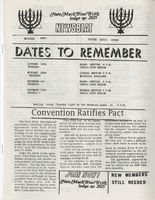Search the Special Collections and Archives Portal
Search Results
Historic American Buildings Survey of Kiel Ranch Photograph Collection
Identifier
Abstract
The Historic American Buildings Survey of Kiel Ranch Photograph Collection contains 45 black-and-white photographs of the buildings on Kiel Ranch from 1988. The buildings documented by the collection are the park mansion, the adobe structure, an old house, the foreman's house, a shed referred to as the "Doll House," a brown house, a cinderblock house, a wooden duplex, and a livestock shed.
Archival Collection
Ferron and Bracken Photograph Collection
Identifier
Abstract
The Ferron and Bracken Photograph Collection depicts Southern and Central Nevada and other western states from 1890 to 1961. The photographs primarily depict the development and growth of early Las Vegas, Nevada; mines and mining operations in Southern and Central Nevada; towns and mines in Nevada; and the Hoover (Boulder) Dam and the Colorado River.
Archival Collection

Transcript of Interview with Michael Drakulich by Jane Finfrock, May 8, 1979
Date
Archival Collection
Description
Text

Stewart family real estate documents
Date
Archival Collection
Description
Stewart family real estate documents
Text

Nate Mack B'nai B'rith lodge no. 2825 Newsbeat newsletters, item 01
Description
Newsbeat newsletter for October 1990
Julius Jensen Professional Papers
Identifier
Abstract
The Julius Jensen Professional Papers (1630-1979) consist of medical research notes, medical journal reprints, manuscript and article drafts, professional and personal correspondence, business and financial records, investment information, travel information, photographic prints, art prints, and collectible books and magazines.
Archival Collection
Kiel Ranch Preservation Committee Records
Identifier
Abstract
The Kiel Ranch Preservation Committee Records (1973-2005) document the activities of the North Las Vegas Bicentennial Committee (1973-1976) and its successor, the Advisory Board for Kiel Ranch (1978-1995), in their efforts to restore Kiel Ranch, one of the earliest non-indigenous settlement sites in the Las Vegas, Nevada area. The collection contains various official reports on Kiel Ranch, proposals on how to restore Kiel Ranch, chronological files for each year of the project, and newspaper clippings on the status of Kiel Ranch.
Archival Collection
International Food Service Executives Association Records
Identifier
Abstract
The International Food Service Executive Association (IFSEA) Records contain the organizational records from the IFSEA dating from 1916 to 2010. Included are meeting programs and minutes, menus, conference reports and proceedings, financial reports, newsletters, award certificates, scrapbooks, and stewards and caterers records focusing on the hospitality and food service industry. Materials are from both national and regional branches of the organization and include records from the United States military, with whom IFSEA has partnered with since the 1960s. Club artifacts and trophies are also contained in the collection.
Archival Collection
Tonopah Mining Company Records
Identifier
Abstract
The Tonopah Mining Company Records derive from the office of the company’s general manager in Tonopah, Nevada and consist of documents directly generated by its mining and milling operations from 1901 through 1941. The collection includes daily work reports, assay reports and certificates, employee time cards, invoices and receipts for mining equipment and supplies, monthly stores reports, and the company’s numerous insurance policies. Several of the company’s annual reports, including an original typescript copy of the 1907 annual report, are included in the collection. Additionally, select records from the company's subsidiary, Desert Power and Mill Company, as well as the Tonopah and Goldfield Railroad, which include overcharge claims, freight and repair bills, and delivery receipts are included in the collection.
Archival Collection
North Las Vegas Bicentennial Committee Photographs and Drawings of Kiel Ranch
Identifier
Abstract
The North Las Vegas Bicentennial Committee Photographs and Drawings of Kiel Ranch document the buildings on Kiel (Kyle) Ranch in 1974. As part of the commemoration of the United States bicentennial, the North Las Vegas City Council elected to restore Kiel Ranch, which was one of the first non-indigenous settlements in the Las Vegas Valley. The materials include black-and-white photographs of Kiel Ranch as it was in 1974 as well as architectural drawings of planned renovations to the main house, the Brown House, the foreman's house, and the ranch hands' house.
Archival Collection
